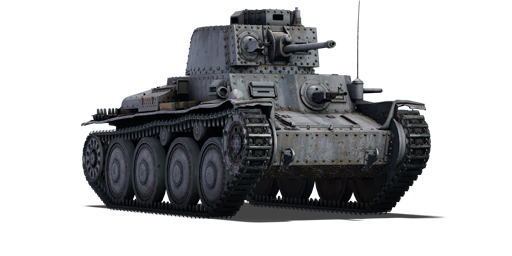



Pz.Kpfw.38(t) was the German designation for the Czech LT vz.38, which fell into German hands after the occupation of Czechoslovakia in the spring of 1939. Ausf. A, the first series production modification of the LT vz.38 tanks, were the first 150 vehicles produced from May to November 1939. They were originally intended for the Czechoslovakian army but were seized by the Germans at the factory before being delivered to the troops. After testing the vehicles, they not only pressed the already built LT vz.38 tanks into service but also continued their production, constantly modernising them. The Pz.Kpfw.38(t) Ausf. A participated in the Polish, French, and Balkan campaigns, where it proved to be a very effective combat vehicle. The last campaign in which the tank took part was Operation Barbarossa (the invasion of the USSR), where it became apparent that the machine could no longer effectively conduct combat operations, as its armour and armament were significantly inferior to the new Soviet medium and heavy tanks.
The Pz.38(t) A was introduced during the Closed Beta Test for Ground Forces before Update 1.41. Although classified as a light tank, in terms of armour protection it can rival most medium tanks. In terms of combined armour protection, survivability, and firepower, the vehicle is versatile in combat and can easily take on a leading role in offensives, hold defensive positions, be involved in flanking manoeuvres, or be used in secondary roles. Always try to make use of your gun depression, hiding your hull behind terrain and obstacles, while exposing only your turret to the enemy.
| Ammunition | Type | Armor penetration (mm) at a distance: | |||||
|---|---|---|---|---|---|---|---|
| 10 m | 100 m | 500 m | 1000 m | 1500 m | 2000 m | ||
| APC | 62 | 59 | 45 | 32 | 23 | 17 | |
| APC | 61 | 58 | 44 | 31 | 22 | 15 | |
| APCR | 86 | 77 | 47 | 26 | 14 | 8 | |
| Belt | Belt filling | Armor penetration (mm) at a distance: | |||||
|---|---|---|---|---|---|---|---|
| 10 m | 100 m | 500 m | 1000 m | 1500 m | 2000 m | ||
| AP/AP/AP-T | 13 | 12 | 7 | 3 | 2 | 0 | |












Mobility | |
|---|---|
Protection |
|---|
Firepower | |
|---|---|